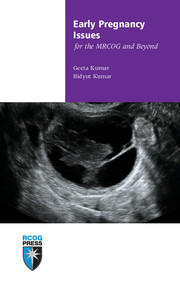Book contents
- Frontmatter
- Contents
- Dedication and acknowledgement
- About the authors
- Abbreviations
- Preface
- 1 Embryogenesis and physiology
- 2 Miscarriage
- 3 Recurrent miscarriage
- 4 Ectopic pregnancy
- 5 Trophoblastic disease
- 6 Hyperemesis gravidarum
- 7 Abdominal and pelvic pain in early pregnancy
- 8 Prescribing issues
- 9 Ultrasound and screening
- Further reading
- Index
- Published titles in the MRCOG and Beyond series
1 - Embryogenesis and physiology
Published online by Cambridge University Press: 05 July 2014
- Frontmatter
- Contents
- Dedication and acknowledgement
- About the authors
- Abbreviations
- Preface
- 1 Embryogenesis and physiology
- 2 Miscarriage
- 3 Recurrent miscarriage
- 4 Ectopic pregnancy
- 5 Trophoblastic disease
- 6 Hyperemesis gravidarum
- 7 Abdominal and pelvic pain in early pregnancy
- 8 Prescribing issues
- 9 Ultrasound and screening
- Further reading
- Index
- Published titles in the MRCOG and Beyond series
Summary
The average duration of pregnancy is 266 days (38 weeks) after ovulation or 280 days (40 weeks) after the first day of the last menstrual period (LMP). This equates to a period of just over 9 calendar months. Traditionally, the age of a pregnancy has been calculated from the first day of the LMP but it is easy to appreciate that this cannot be the same as the age of the embryo or the fetus, as conception does not occur until after ovulation has taken place: about 14 days after the LMP. Those involved with in vitro fertilisation usually refer to the age of embryo as being equivalent to the number of days elapsed since fertilisation and this is commonly referred to as ‘gestational days’. Thus, a traditionally defined 10-week pregnancy is equivalent to 56 gestational days. This concept is important to the understanding of timing of development of the embryo which, in turn, can explain the effects of certain teratogens on different embryonic or fetal structures. The embryo changes to a fetus 10 weeks after the LMP: at 56 gestational days (8 weeks) (Table 1.1). This is an important transition because the vast majority of the adult bodily structures are recognisable by the end of the embryonic stage.
Part of the urogenital tract develops from the primitive gut tube, which also gives rise to many other organs, the most important of which are:
• the thyroid and pituitary glands
• the lungs
• the pancreas
• the bile ducts and gall bladder
• the urogenital system.
- Type
- Chapter
- Information
- Early Pregnancy Issues for the MRCOG and Beyond , pp. 1 - 14Publisher: Cambridge University PressPrint publication year: 2011

